Inside The New York Botanical Garden
Archive: July 2010
Posted in Exhibitions, The Edible Garden on July 14 2010, by Plant Talk
| Written by Burpee Home Gardens Team. Burpee is a Supporting Sponsor of The Edible Garden. |
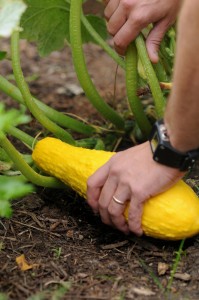 The interesting thing about home vegetable gardens (and one that experienced gardeners learn to perfect), is that they evolve with the seasons. From cool to warm to hot, and back again, each of these cycles provides an opportunity to plant different crops for a maximized garden harvest.
The interesting thing about home vegetable gardens (and one that experienced gardeners learn to perfect), is that they evolve with the seasons. From cool to warm to hot, and back again, each of these cycles provides an opportunity to plant different crops for a maximized garden harvest.
One of the best-loved varieties that supply multi-seasonal recipes at your table is the trusty squash. We love the fact that you can grow a squash for almost every holiday recipe, from the Fourth of July cookout to Christmas dinner. Whether in the salad bowl or on the grill, in soup or in bread, squash can do it all. You can even eat squash blossoms—cooked or raw! Blossoms are a special treat reserved for only the best restaurants (and home gardeners) because of their perishable and delicate nature. But best of all, squash is one of the easiest and most prolific vegetables you can plant in your garden, and with success.
Native to the Americas, squash can be divided into two types: summer and winter. Summer squashes ripen quickly (as fast as 50 days). Winter squashes and their hard rinds ripen later. Summer squashes such as yellow, crookneck, and zucchini are eaten soon after harvesting—skin and all. They’re great eaten raw (with vegetable trays), steamed, grilled, or boiled. You can stuff them and bake them or grate larger-sized ones for delicious and flavorful breads. Winter squashes such as acorn and butternut, are often cut in half and baked, or boiled and then mashed like potatoes.
Read More
Posted in Gardening Tips on July 12 2010, by Sonia Uyterhoeven
 |
Sonia Uyterhoeven is Gardener for Public Education. Join her each weekend for home gardening demonstrations on a variety of topics in the Home Gardening Center. |
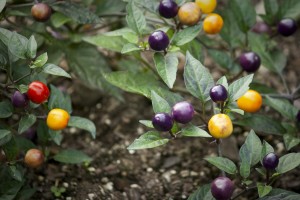 In my blog post last week I discussed combining color and texture in the vegetable garden. This week we will look at some new introductions and some old favorites that are worthy additions to a rainbow garden.
In my blog post last week I discussed combining color and texture in the vegetable garden. This week we will look at some new introductions and some old favorites that are worthy additions to a rainbow garden.
Gardeners who grow beets are familiar with the classic heirloom, Beta vulgaris ‘Chioggia’. It is incredibly sweet and mild when cooked, but once you slice through its red skin, its outstanding feature is revealed: alternating red and white rings. It retains its impressive bull’s eyes even when baked whole. This year growers such as Johnny’s Select Seeds and Parks Seeds are touting an improved version of this Italian classic called ‘Chioggia Guardsmark’.
When we think of butterhead lettuce we generally think of hydroponically grown, buttery-smooth green heads. I grew up on this Boston-type lettuce, and it is still a favorite choice in my family’s household. Some popular green varieties are ‘Buttercrunch’ and ‘Butterking’. The red-tinged heirloom varieties ‘Pirat’ and ‘Yugoslavian Red’ have long been a staple in my garden. This year a heat tolerant red variety called ‘Skyphos’ entered the market. It looks sensational. It is not too late to try both the beet and the lettuce as fast fall crops.
Read More
Posted in Exhibitions, The Edible Garden on July 9 2010, by Sonia Uyterhoeven
Chef Keith Snow Grows His Own; Shares Secrets, Tips
Many Americans want to take part in the harvest revolution and eat foods grown at home to ensure freshness, good taste, and reasonable cost. But what if you live in an apartment building—are you out of luck? Actually, no. Many people who live in urban areas around the country are taking part in the local food craze by growing food in containers.
Before you run out to the nursery to get started, consider whether your balcony or rooftop can handle the weight and whether your building permits it: A large container of wet soil can weigh 50–100 pounds or more. Multiply that by the number of containers you’d like, and check whether your site can handle the extra load. (If regulations do not allow for you to grow outdoors, you can certainly grow herbs indoors near a sunny window.)
Once you’ve resolved where to place your plants, you’ll need to decide what to grow. Some plants are perfectly suited to containers, others are not. I like to advise people to create a kitchen garden in containers that can produce herbs, lettuces, tomatoes, cucumbers, eggplant, and peppers. These crops can thrive in containers and provide a lot of food and recipe diversity.
Read More
Posted in Exhibitions, The Edible Garden on July 8 2010, by Plant Talk
 |
Cathy Erway, author of The Art of Eating In, will present cooking demonstrations at The Edible Garden Conservatory Kitchen on Saturday, July 10, at 1 and 3 p.m.. |
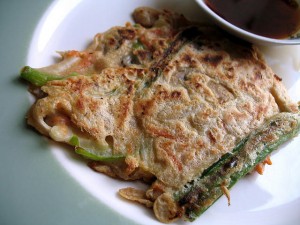 Perhaps you’ve tried them at Korean restaurants, with spicy kimchee in the batter. Maybe you’ve heard of them and guessed they were more or less like scallion pancakes at Chinese restaurants, but with more stuff. Maybe you’ve even taken a crack at making them at home, with strips of leftover meat or seafood. In any case, you are probably well aware of how simple yet delicious a crisp, savory pancake hot off the pan can be. I’ve found that holds true with almost any ingredient you mix into the batter.
Perhaps you’ve tried them at Korean restaurants, with spicy kimchee in the batter. Maybe you’ve heard of them and guessed they were more or less like scallion pancakes at Chinese restaurants, but with more stuff. Maybe you’ve even taken a crack at making them at home, with strips of leftover meat or seafood. In any case, you are probably well aware of how simple yet delicious a crisp, savory pancake hot off the pan can be. I’ve found that holds true with almost any ingredient you mix into the batter.
My favorite way to enjoy savory pancakes, though, is just with fresh veggies. Red onions and apples is a wildly satisfying combo in the winter. Shredded carrots and parsnips go great together, too. But in the summer, the vibrant flavors of everything that’s in season can’t be beat. Try making the pancakes with thinly sliced peppers of all shades and mixing fresh corn into the batter along with scallions and another type of onion. For the recipe below, I use a filling of mostly shredded zucchini.
Read More
Posted in Emily Dickinson, Exhibitions on July 7 2010, by Plant Talk
 |
Jane Dorfman is Reference Librarian/Exhibitions Coordinator in the LuEsther T. Mertz Library. |
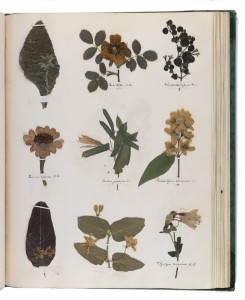 How did Emily Dickinson prepare her herbarium? That is the topic addressed in the current window display of the LuEsther T. Mertz Library’s Rare Book and Folio Room.
How did Emily Dickinson prepare her herbarium? That is the topic addressed in the current window display of the LuEsther T. Mertz Library’s Rare Book and Folio Room.
At 14 years of age, Dickinson, inspired by her readings and botanical studies at Amherst Academy, gathered, dried, pressed, mounted, and identified over 400 plants for her herbarium. She was enthusiastic about the project. She asked her friend Abiah Root in a letter if she had made a herbarium yet and encouraged her to pursue such a project. Dickinson even enclosed a geranium leaf for her friend to press.
In the Library’s William D. Rondina and Giovanni Foroni LoFaro Gallery exhibition of Dickinson’s life, which runs through August 1, a digitized version of the poet’s herbarium is on display. Made available through Turn the Pages Technology, visitors can view Dickinson’s original herbarium virtually by “turning” the pages on a touchscreen. A printed version of Dickinson’s herbarium is included in the Rare Book and Folio Room display.
This small exhibit shows how 19th-century botany enthusiasts created herbaria. The collecting tin (known as a vasculum) belonging to the celebrated botanist John Torrey is on display as well as a botany text by noted instructor Mrs. Almira Lincoln Phelps, a text that Dickinson used in her studies.
Also on view are the materials used in creating a herbarium today, including glue, twine, mounting paper, blotting paper, and a herbarium press. In addition, dried specimens of Monotropa uniflora (Indian pipe) and Heliotropium arborescens L. (heliotrope), two of Dickinson’s favorite plants, are presented, courtesy of the Garden’s William and Lynda Steere Herbarium..
The Rare Book and Folio Room display can be viewed during Library hours through Labor Day.
Posted in Exhibitions, The Edible Garden on July 6 2010, by Sonia Uyterhoeven
 |
Sonia Uyterhoeven is Gardener for Public Education. Join her each weekend for home gardening demonstrations on a variety of topics in the Home Gardening Center. |
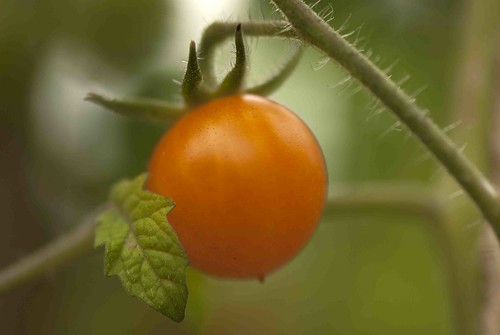 Garden writer Sydney Edison studies how great art masters combine color on their canvas and uses those lessons as inspiration for the color combinations in her patio displays. Color in the vegetable garden is equally important. It can transform an ordinary or utilitarian space into a work of art.
Garden writer Sydney Edison studies how great art masters combine color on their canvas and uses those lessons as inspiration for the color combinations in her patio displays. Color in the vegetable garden is equally important. It can transform an ordinary or utilitarian space into a work of art.
Design your vegetable garden with color in mind by paying attention to the color of fruit, flowers, and foliage. A bed of yellow and red peppers can be accentuated by repeating the color with a surrounding edge of marigolds. Scarlet runner beans can climb up vertical structures that will pick up the hot color theme.
Repeating color themes is one of the simplest and most effective ways to both literally and figuratively soup-up your vegetable garden. This can be done with vegetables but also enhanced by colorful herbs and summer annuals that can find their way into a vase on the kitchen table.
Read More
Posted in Exhibitions, Programs and Events, The Edible Garden on July 2 2010, by Plant Talk
Children Learn How Pollinators Turn Flowers to Fruits
 |
Noelle V. Dor is Museum Education Intern in the Everett Children’s Adventure Garden. |
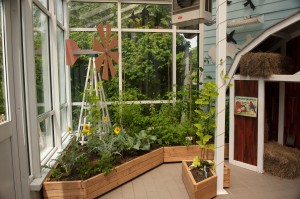 As the school year winds to a close and summer settles in, The New York Botanical Garden invites us to delight our senses and our bellies with The Edible Garden: Growing and Preparing Good Food. Visitors are exposed to a wide variety of edible roots, shoots, and fruits and also experience the many ways our favorite foods go from plant to plate.
As the school year winds to a close and summer settles in, The New York Botanical Garden invites us to delight our senses and our bellies with The Edible Garden: Growing and Preparing Good Food. Visitors are exposed to a wide variety of edible roots, shoots, and fruits and also experience the many ways our favorite foods go from plant to plate.
In its Flowers-to-Fruits program, the Everett Children’s Adventure Garden highlights one essential part of this transformative process: pollination. Here families explore the diversity of flower colors, shapes, and scents as well as the mutually beneficial relationships between flowers and the animals they attract.
The word pollination probably conjures up in most people the classic image of a bee buzzing from flower to flower. While this visual is definitely appropriate, many other animals—butterflies, moths, hummingbirds, bats, ants—act as important pollinators as well. They gain nourishment from the sweet nectar of flowers and, in turn, the flowers are able to change into fruits. Seeing pollination in action throughout the Garden makes me wonder how many of the fruits we eat result from this intricate plant–animal exchange.
Read More
Posted in Exhibitions, The Edible Garden on July 1 2010, by Plant Talk
Oceana Pastry Chef Jansen Chan Shares Preview of 2 New Creations
 |
Jansen Chan is Executive Pastry Chef of Oceana in New York. He will give cooking demonstrations at The Edible Garden on Sunday, July 4. |
Summer is the toughest time for any pastry chef. The abundance of great seasonal produce to put on the menu is too overwhelming. Whether it’s cherries, peaches, strawberries, blueberries or melons, I love them all. When creating a new dish, I want to remain true to the fruit and allow its complexity to shine through—usually the produce is the star with delicious, supporting players to give contrast in texture and flavors.
For The Edible Garden this year, I have the honor of celebrating raspberries. I’ve created two dishes for the event, designed for the everyday home chef. I wanted to make easy dishes that people wouldn’t be intimidated by. I also wanted to make something that wasn’t too plain or boring.
I’m most excited by the Raspberry Yogurt Fool with Basil. A fool (besides the obvious) is simply a fruit puree folded with whipped cream. Here, I’ve lightened it with some Greek yogurt and sweetened it with just a touch of honey. The fresh basil brings freshness and relief from the natural tartness in the dishes. It’s the perfect, cool summer treat!
My other dish is pure indulgence: It’s an Upside-Down Raspberry Chocolate Cake. It’s exactly as it sounds—a moist, chocolate cake baked with a sticky, sweet, and tart raspberry topping. How could it go wrong?
Come to The Edible Garden Sunday to see Chef Jansen Chan prepare these desserts, so that you can make them at home.
Get Your Tickets
 The interesting thing about home vegetable gardens (and one that experienced gardeners learn to perfect), is that they evolve with the seasons. From cool to warm to hot, and back again, each of these cycles provides an opportunity to plant different crops for a maximized garden harvest.
The interesting thing about home vegetable gardens (and one that experienced gardeners learn to perfect), is that they evolve with the seasons. From cool to warm to hot, and back again, each of these cycles provides an opportunity to plant different crops for a maximized garden harvest.










